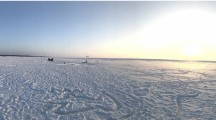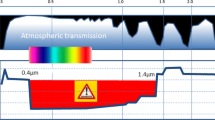Abstract
A downburst is a strong downdraft that causes radiating, catastrophic winds at or near the ground. Relevant research conducted in the past decades shows that downbursts not only bring damage to the built environment but also have surprisingly destructive effects on aircraft and other flying objects. However, due to the complexity of atmospheric phenomena and limited measurement datasets, many uncertainties remain to be clarified in the understanding and modelling of the downburst wind field. To further explore the evolution characteristics of thunderstorms, this study uses data recorded during thunderstorms by a Doppler profiler of the Hong Kong Observatory and a near-ground anemometer installed at the Hong Kong International Airport to conduct a detailed feature analysis of the vertical profile and turbulence characteristics of downbursts within the atmospheric boundary layer. Based on long-term field measurements during thunderstorm events, the occurrence of a thunderstorm should be determined by a combination of simultaneous variations in multiple meteorological factors, including wind speed and direction, vertical wind speed, and signal-to-noise ratio (SNR). During thunderstorms, extreme wind speeds occurred in the lower atmosphere and the height of the local peaks seems to be stable in the thunderstorm wind profiles. In addition, both methods, which consider a constant mean component (stationary) and a slowly varying mean component (non-stationary), are used to decompose the measured wind speed and are then compared to investigate the turbulence characteristics of downbursts. Although the gust factor and turbulence intensity show some deviation due to the influence of atmospheric stratification instability, this effect does not appear to be reflected in the turbulence integral scale.

















Similar content being viewed by others
Data Availability
The data that support the findings of this study are available from Hong Kong Observatory but restrictions apply to the availability of these data, which were used under license for the current study, and so are not publicly available. Data are however available from the authors upon reasonable request and with permission of Hong Kong Observatory. In addition, the raw data involved in this study has been stored on an online platform (https://pan.baidu.com/).
References
Asano K, Iida Y, Uematsu Y (2019) Laboratory study of wind loads on a low-rise building in a downburst using a moving pulsed jet simulator and their comparison with other types of simulators. J Wind Eng Ind Aerodyn 184:313–320
Brooks HE (2013) Severe thunderstorms and climate change. Atmos Res 123:129–138
Businger JA, Wyngaard JC, Izumi Y, Bradley EF (1971) Flux-profile relationships in the atmospheric surface layer. J Atmos Sci 28(2):181–189
Canepa F, Burlando M, Solari G (2020) Vertical profile characteristics of thunderstorm outflows. J Wind Eng Ind Aerodyn 206:104332
Canepa F, Burlando M, Hangan H, Romanic D (2022) Experimental Investigation of the near-surface flow dynamics in downburst-like impinging jets immersed in ABL-like winds. Atmosphere 13(4):621
Cao S, Tamura Y, Kikuchi N, Saito M, Nakayama I, Matsuzaki Y (2009) Wind characteristics of a strong typhoon. J Wind Eng Ind Aerodyn 97(1):11–21
Chaudhuri S, Khan F, Das D, Mondal P, Dey S (2020) Probing for overshooting as extreme event of thunderstorms. Nat Hazards 102:1571–1588
Choi EC (2004) Field measurement and experimental study of wind speed profile during thunderstorms. J Wind Eng Ind Aerodyn 92(3–4):275–290
Devi M, Patgiri S, Medhi A, Das S, Ray KP (2020) Thunderstorm dynamics through wind profiling features: the first observation by stratospheric–tropospheric radar of GU. Nat Hazards 101(2):573–594
Elawady A, Aboshosha H, El Damatty A, Bitsuamlak G, Hangan H, Elatar A (2017) Aero-elastic testing of multi-spanned transmission line subjected to downbursts. J Wind Eng Ind Aerodyn 169:194–216
Engineering Sciences Data Unit (1985) Characteristics of atmospheric turbulence near the ground. Part II: single point data for strong winds (neutral atmosphere). ESDU 85020
Fang Z, Wang Z, Li Z, Yan J, Huang H (2023) Wind field characteristics of stationary and moving downbursts based on the test of impinging jet with a movable nozzle. J Wind Eng Ind Aerodyn 232:105266
Flay RGJ, Stevenson DC (1988) Integral length scales in strong winds below 20 m. J Wind Eng Ind Aerodyn 28(1–3):21–30
Fujita TT (1981) Tornadoes and downbursts in the context of generalized planetary scales. J Atmos Sci 38(8):1511–1534
Golder D (1972) Relations among stability parameters in the surface layer. Bound-Layer Meteorol 3(1):47–58
Grinn-Gofroń A, Strzelczak A (2013) Changes in concentration of Alternaria and Cladosporium spores during summer storms. Int J Biometeorol 57:759–768
He Y, Li Q, Chan P, Zhang L, Yang H, Li L (2020) Observational study of wind characteristics from 356-meter-high Shenzhen Meteorological Tower during a severe typhoon. Wind Struct 30(6):575–595
He Y, Liu Y, Wu M, He Y, Fu J (2022) Observational study of typhoon effects on the oval-shaped 330 m high Zhuhai Center Tower. J Build Eng 60:105135
Iida Y, Uematsu Y, Gavanski E (2015) A study of downburst-induced wind loading on buildings. J Wind Eng 40(2):40–49
Ishizaki H (1983) Wind profiles, turbulence intensities and gust factors for design in typhoon-prone regions. J Wind Eng Ind Aerodyn 13(1–3):55–66
Jesson M, Sterling M (2018) A simple vortex model of a thunderstorm downburst—a parametric evaluation. J Wind Eng Ind Aerodyn 174:1–9
Jesson M, Lombardo FT, Sterling M, Baker C (2019) The physical simulation of a transient, downburst-like event—how complex does it need to be? J Wind Eng Ind Aerodyn 189:135–150
Jiang F, Zhang M, Li Y, Yan T, Zhang J (2022) Field measurement analysis of wind parameters and nonstationary characteristics in mountainous terrain: focusing on cooling windstorms. J Wind Eng Ind Aerodyn 230:105175
Liu CH, Leung DY, Man AC, Chan PW (2010) Computational fluid dynamics simulation of the wind flow over an airport terminal building. J Zhejiang Univ-SCIENCE A 11:389–401
Liu W, Wang S, Zhou Y, Wang L, Zhu J, Wang F (2016) Lightning-caused forest fire risk rating assessment based on case-based reasoning: a case study in DaXingAn Mountains of China. Nat Hazards 81:347–363
Luo YP, Fu JY, Li QS, Chan PW, He YC (2020) Observation of Typhoon Hato based on the 356-m high meteorological gradient tower at Shenzhen. J Wind Eng Ind Aerodyn 207:104408
Masters FJ, Vickery PJ, Bacon P, Rappaport EN (2010) Toward objective, standardized intensity estimates from surface wind speed observations. Bull Am Meteorol Soc 91(12):1665–1682
Romanic D, Nicolini E, Hangan H, Burlando M, Solari G (2020) A novel approach to scaling experimentally produced downburst-like impinging jet outflows. J Wind Eng Ind Aerodyn 196:104025
Romanic D, Taszarek M, Brooks H (2022) Convective environments leading to microburst, macroburst and downburst events across the United States. Weather Clim Extremes 37:100474
Schlegel K, Diendorfer G, Thern S, Schmidt M (2001) Thunderstorms, lightning and solar activity—Middle Europe. J Atmos Solar Terr Phys 63(16):1705–1713
Selvam RP, Holmes JD (1992) Numerical simulation of thunderstorm downdrafts. J Wind Eng Ind Aerodyn 44(1):2817–2825
Shi J, Cui L (2012) Characteristics of high impact weather and meteorological disaster in Shanghai, China. Nat Hazards 60:951–969
Shu ZR, Li QS, He YC, Chan PW (2015) Gust factors for tropical cyclone, monsoon and thunderstorm winds. J Wind Eng Ind Aerodyn 142:1–14
Shu ZR, Li QS, He YC, Chan PW (2017) Vertical wind profiles for typhoon, monsoon and thunderstorm winds. J Wind Eng Ind Aerodyn 168:190–199
Solari G, De Gaetano P, Repetto MP (2015) Thunderstorm response spectrum: fundamentals and case study. J Wind Eng Ind Aerodyn 143:62–77
Von Karman T (1948) Progress in the statistical theory of turbulence. Proc Natl Acad Sci 34(11):530–539
Wang Q, Luo K, Wu C, Zhu Z, Fan J (2022) Mesoscale simulations of a real onshore wind power base in complex terrain: wind farm wake behavior and power production. Energy 241:122873
Wang Q, Luo K, Wu C, Tan J, He R, Ye S, Fan J (2023) Inter-farm cluster interaction of the operational and planned offshore wind power base. J Clean Prod 396:136529
Zhang S, Yang Q, Solari G, Li B, Huang G (2019) Characteristics of thunderstorm outflows in Beijing urban area. J Wind Eng Ind Aerodyn 195:104011
Funding
This study is funded by three projects from the National Natural Science Foundation of China (Grant Nos. 51925802, 52178465 and 52208471) and supported by the 111 Project (Grant No. D21021), Municipal Science and Technology Planning Project of Guangzhou (Grant No. 20212200004).
Author information
Authors and Affiliations
Contributions
All authors have read and agreed to the current version of the manuscript. YH: conceptualization, writing—original draft, methodology; JC: writing—original draft, resources; RW: investigation, validation; XH: data curation, investigation; PC: data curation; JF: conceptualization, writing—review and editing, funding acquisition.
Corresponding author
Ethics declarations
Conflict of interest
The authors declare that they have no known competing financial interests or personal relationships that could have appeared to influence the work reported in this paper.
Ethical approval
Not applicable—this study not involving humans or animals.
Informed consent
Not applicable—this study not involving humans.
Additional information
Publisher's Note
Springer Nature remains neutral with regard to jurisdictional claims in published maps and institutional affiliations.
Rights and permissions
Springer Nature or its licensor (e.g. a society or other partner) holds exclusive rights to this article under a publishing agreement with the author(s) or other rightsholder(s); author self-archiving of the accepted manuscript version of this article is solely governed by the terms of such publishing agreement and applicable law.
About this article
Cite this article
He, Y., Cai, J., Wang, R. et al. Observation of downburst wind characteristics using the Doppler profiler and near-ground measurements. Nat Hazards 120, 4829–4851 (2024). https://doi.org/10.1007/s11069-024-06410-w
Received:
Accepted:
Published:
Issue Date:
DOI: https://doi.org/10.1007/s11069-024-06410-w




